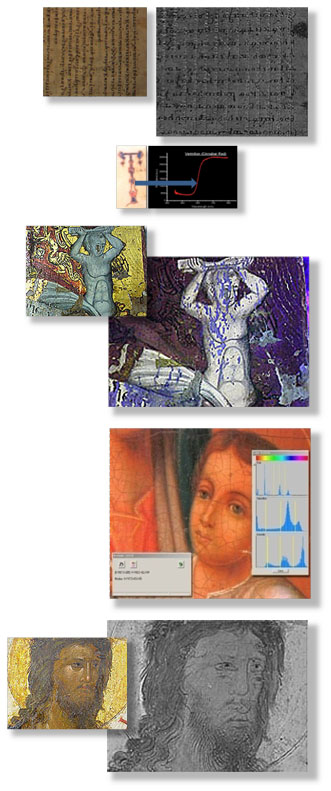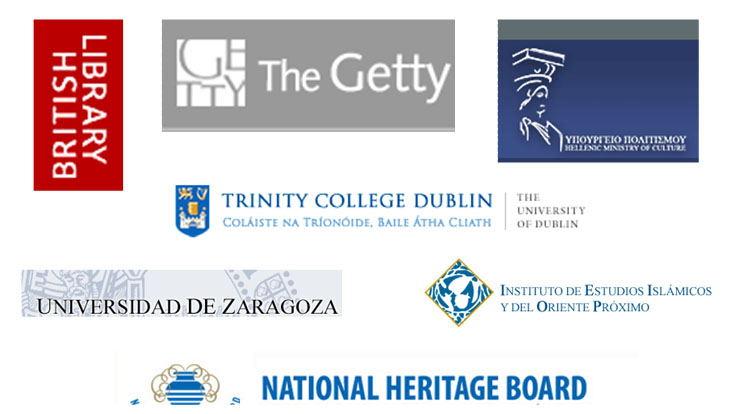Summary Novel methods and technology platforms developed Applications
Colposcopy Endoscopy Microscopy Neurology Imaging Technology in Art Preservation
Tomorrow's Technology Reveals the Past
The identification of painting materials, including pigments, binding materials, varnishes etc., is of essential importance for both artistic and scientific analysis.
In several cases, this analysis is of key importance for assisting authentication and for assessing the natural condition of the object of art. Compositional analysis often requires destructive sampling and subsequent ex-situ analysis. However, invasive investigations have the drawback of being harmful to the artwork and provide only point information that is not necessarily representative of the object area under analysis.
I feel proud for being able to serve the society by contributing to discovering and to preserving our cultural heritage. I am the first ever who developed multimodal spectral imagers integrating almost all the imaging and optical diagnostic techniques used for the analysis and documentation of art and historic objects in one hi-end imaging system.
The system combines high definition imaging with high resolution spectroscopy in one user-friendly, portable work station.
A series of narrow-band images are automatically captured, across the visible and the non-visible parts of the optical spectrum (infrared, ultraviolet) and a full spectrum per image pixel is be calculated and displayed.

Materials composing the object under analysis are identified and mapped on the basis of spectral analysis and spectral classification.
Important structural and compositional characteristics, invisible by conventional color imaging devices, are revealed with real-time, multi-band imaging within the visible and non-visible parts of the spectrum.
Our specially developed spectral cameras for artwork manuscript and monument non destructive analysis integrate almost all the imaging and optical diagnostic techniques used for the analysis and documentation of art and historic objects in a single hi-end imaging system. These cameras can be configured to perform a series of imaging modalities for improved documentation and for maximizing the diagnostic information. Indicative imaging modes include:
| ✔ Spectral Camera & Imaging Spectrometer for | |
|
painting material identification assisting artwork authentication reading of erased or overwritten manuscripts |
|
| ✔ Ultraviolet Reflectance Camera for imaging | |
|
surface features, roughness, brush strokes etc varnishes and other coatings on-line control of coating removal material identification |
|
| ✔ Ultraviolet Fluorescence Camera for | |
|
imaging of binding media, coatings etc. detecting retouching, conservation interventions etc assessing the natural condition of the artwork |
|
| ✔ High-Definition Color Camera and Imaging Colorimeter for | |
|
accurate documentation and color reproduction per-pixel color measurement and comparison histogram-based color segmentation and mapping objective evaluation of restoration processes |
|
| ✔ Multi-band Infrared Camera for | |
|
imaging underdrawings, cracks, pentimenti etc. material identification assisting conservation decision-making |
|
| ✔ False Color Infrared Camera for | |
|
the visualization of of chemically different pigments with similar hue |
|
 |
 |
My history in developing spectral cameras for the non destructive analysis of objects of artistic and historic value goes back to 90’s. The intellectual property rights (IPR) for two older versions that I have developed, have been transferred to Art-Innovation (Holland) and to forth photonics (UK).
In 2013 we completed the development of the new generation of spectral cameras, which enable extremely fast diagnostic scanning and real-time guidance for conservation tasks.

A series of high profile institutions have integrated older or newest versions to their every day research and conservation activities. Some of them are:
- The Getty Conservation Institute/ Museum in Los Angeles (discovered an otherwise invisible inscription on the shroud of the Fayum mummy Herakleides. The relevant article was published in Nature Journal (vol. 453, 8 May 2008, p. 159))
- The British library (to uncover the rewrites of Codex Sinaiticus, the world’s oldest Bible) see Codex Sinaiticus
- The Singapore’s National Heritage Board
Impressive findings on the painting techniques and working style of the painter Wong Shih Yaw, using their IR reflectance and transmittance imaging - The University of Hamburg, Germany
Prof. Jost Gippert (Chair of the Institute of Comparative Linguistics at Frankfurt University, Germany) published the starting volume of a complete edition of the Old Georgian texts preserved in the lower layer of a famous palimpsest of the Austrian National Library, Vienna. With the use our imaging system, more than 95% of the original content has been deciphered and restored. - University of Zaragosa, Spain
Alberto Montaner of the University of Zaragosa, Spain, uses that term The Medievalist Gadget! to describe great value of our cameras for all researchers studying historical manuscripts (The Medievalist Gadget)
Please visit the "Gallery" section of this site and check out a collection of images, which, I am sure, you will find interesting. These images have been obtained by our distinguished collaborators using the cameras described above.
